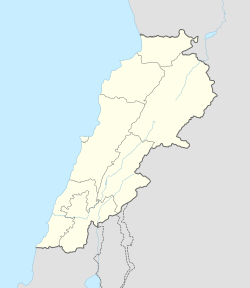Top Qs
Timeline
Chat
Perspective
Jouret Bedran
Municipality in Keserwan-Jbeil, Lebanon From Wikipedia, the free encyclopedia
Remove ads
Jouret Bedran (Arabic: جورة بدران; also spelled Jurat Badran) is a village and municipality located in the Keserwan District of the Keserwan-Jbeil Governorate in Lebanon. The village is 44 kilometres (27 mi) north of Beirut.[1] It has an average elevation of 1200 meters above sea level and a total land area of 120 hectares.[1] The village is bordered by the villages of Yahchouch, Ghbaleh, Azra, Mradiyeh and Hakl El Rayes. Jouret Bedran's inhabitants are Maronites.[2]
Remove ads
History
Historically, it is believed that Phoenicians inhabited the region since remains are found in nearby Ghineh, where historians believe is the resting place of the historical figure Adonis. The region was later occupied by Muslim communities before its destruction at the hands of the Mamluks in 1307. The region was abandoned for the next three centuries until Christian families arrived somewhere during the 17th century. Until 1863, Jouret Bedran was geographically and administratively a part of what was called "Ghbaleh and its farms". In 1863, the inhabitants of Jouret Bedran and Azra, led by Rouhana Zouein, announced their separation from Ghbaleh and a separate entity named "Jouret Bedran and its suburbs" was created, and this, until 1872. In 1872, the inhabitants of Azra, led by Youssef Kamel, then known as Abou Hosn, announced their separation from Jouret Bedran and the installation of their own municipality.
Remove ads
Families
The majority of the village's population holds the Ghanem surname. There are also inhabitants from the Zouein and Awad families.
The Ghanem family is descended from Moussa Ghanem Al-Ghassani, a descendant of the Ghassanids, who were a Christian dynasty in the Levant under the aegis of the Byzantine Empire. Moussa came to Yanouh in the 9th century and settled there. Later, in 1121, some of his descendants moved to Lehfed. Finally, Sarkis Ghanem moved from Lehfed to Jouret Bedran during the 17th century and settled there.
Remove ads
Places of worship
The main place of worship in the village is the Saint Stephen Church that serves as the seat of the Azra-Jouret Bedran parish, inaugurated in 1792 in a joint initiative from the inhabitants of Azra and Jouret Bedran. It is the third church ever built in the region, the first being the Saints Sergius and Bacchus Church built in nearby Ghbaleh in 1780 and the second being the Church of Our Lady also built in Ghbaleh in 1789.
Other places of worship are:
- Saint Joseph Church, built by Father Youssef Ghanem towards the end of the 19th century
- Saint George Church, built by Father Gerges Ghanem II
- Saint Charbel Church
References
Wikiwand - on
Seamless Wikipedia browsing. On steroids.
Remove ads
